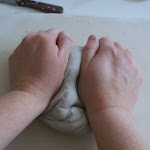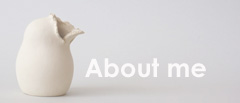 On monday evening I went to our sew/knit/crochet/craft-group called 'the smart buttons' (Knappe Knoopjes) and we had a small celebration for Sinterklaas called 'present night' (pakjesavond) If you want to read more about the tradition of Sinterklaas, you can read it below.
On monday evening I went to our sew/knit/crochet/craft-group called 'the smart buttons' (Knappe Knoopjes) and we had a small celebration for Sinterklaas called 'present night' (pakjesavond) If you want to read more about the tradition of Sinterklaas, you can read it below.It kind of felt like being a kid again and I enjoyed seeing all grown ups being really happy with the gift that someone else made and carefully wrapped. I'm really pleased with mine and I managed to make a quick snapshot during my lunchbreak today.
It's made by Katja and she wrapped up 2 beautiful, colorful pouches, actually a pencil case and a clutch. I'm the kind of person who can never have enough pouches so I'm a very, very lucky girl! :) And they are really well made! Love the fabric too! Thank you, Katja!
 I'll show you later this week what I've been working on at the craftnight. It was too dark to take pictures when I got back from work. So stay tuned...
I'll show you later this week what I've been working on at the craftnight. It was too dark to take pictures when I got back from work. So stay tuned...Sinterklaas explained
In the fourth century a.d. St. Nicholas (in dutch called "Sinterklaas" or "Sint Nicolaas"; in german called "Sankt Nikolaus") was the bishop of Myra, which is now situated in Turkey. According to the legend, he saved his town from starvation. He is also said to have revived three dead children, and to have offered gifts of dowries to poor girls. Some sources say that he died on the sixth of December in 343. In 1087 his relics were taken to Bari in Italy. It is unclear why, according to the Dutch tradition, he comes from Spain. Possibly it has something to do with the fact that St. Nicholas was the patron of sailors. In the 17th century Holland was famous for its navigation. Maybe by contact with Spanish sailors this myth began. It could also explain why St. Nicholas has "zwarte (black) pieten" to help him because the Moors dominated Spain for several hundreds of years. (Another [more popular] explanation for "zwarte piet" being black is that he has come down the chimneys so often [see below] that he can't wash the dirt off.)
His legendary gifts of dowries to poor girls led to the custom of giving gifts to children on the eve of his feast day, 6 December. The companions of St. Nicholas (in Germany and Austria they are called "Knecht Ruprecht" or "Krampus") show the victory over evil. Together with his "pieten" he visits children to punish the evil ones and to reward the good ones. The worst punishment is to be taken to Spain in "zwarte piet's" bag out of which the good children get the sweets (called "pepernoten", "taai-taai", or "schuimpjes") and presents. A less radical punishment is to get the "roede" (rod) instead of presents. Nowadays there are not much evil children any more...
A few weeks before his feastday St. Nicholas comes to Holland (and Belgium) on his steamer with all his "pieten" and the presents which they prepared in Spain during the year. This event can be seen on Dutch television. From his arrival in Holland till his feastday the children can put their shoes in front of the fireplace. During the night St. Nicholas visits all the houses by travelling over the roofs on his horse, traditionally a white/grey (called "Schimmel" in dutch), and "zwarte piet" enters the houses through the chimney to put little presents in the children's shoes. Sometimes the children put straw, carrots and water near the shoe for the horse.
On the eve of his feast day St. Nicholas visits all children. After knocking on the door he gives them a bag full of presents (if they were good children). Early in the morning of 6 December, when he has visited everyone, he leaves and goes back silently to Spain, to come back next year.
[Source: Coone.com]









